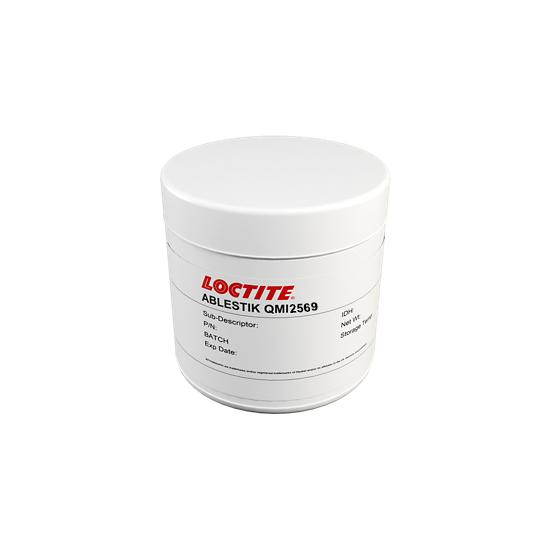LOCTITE ABLESTIK QMI2569
- Silver glass die attach
- Excellent adhesion
- Excellent RGA moisture results
Product Description
LOCTITE ABLESTIK QMI 2569 is a wide temperature processing, no-dry, silver glass die attach adhesive for the attachment of integrated circuits in both solder seal and glass seal hermetic packages. The material can allow the simultaneous processing of die attach and leadframe embedding, while producing a void-free bondline for maximum thermal dissipation.
LOCTITE ABLESTIK QMI 2569 shows excellent adhesion when processed between 380°C to 440°C for small die (.300” x .300”), and between 390°C to 440°C for large die. Excellent RGA moisture results are acquired through the use of lead borate glass. This paste can only be used in hermetic packages. The QMI 2569 also offers improved processability by allowing in-line drying during the firing process on die as large as .800” x .800”. Either multi-needle or starfish can apply the material.
LOCTITE ABLESTIK QMI2569 can only be used in hermetic packaging applications.
Technical Specifications
| Thermal Properties | |
| Glass Transition Temperature (Tg) Glass Transition Temperature (Tg) The glass transition temperature for organic adhesives is a temperature region where the polymers change from glassy and brittle to soft and rubbery. Increasing the temperature further continues the softening process as the viscosity drops too. Temperatures between the glass transition temperature and below the decomposition point of the adhesive are the best region for bonding. The glass-transition temperature Tg of a material characterizes the range of temperatures over which this glass transition occurs. | 250 °C |
| Thermal Conductivity Thermal Conductivity Thermal conductivity describes the ability of a material to conduct heat. It is required by power packages in order to dissipate heat and maintain stable electrical performance. Thermal conductivity units are [W/(m K)] in the SI system and [Btu/(hr ft °F)] in the Imperial system. | 60 W/m.K |
| Physical Properties | |
| Thixotropic index Thixotropic index Thixotropic Index is a ratio of a material s viscosity at two different speeds in Ambient temperature, generally different by a factor of ten. A thixotropic material s viscosity will decrease as agitation or pressure is increased. It indicates the capability of a material to hold its shape. Mayonnaise is a great example of this. It holds its shape very well, but when a shear stress is applied, the material easily spreads. It helps in choosing a material in accordance to the application, dispense method and viscosity of a material. | 8 |
| Viscosity Viscosity Viscosity is a measurement of a fluid’s resistance to flow. Viscosity is commonly measured in centiPoise (cP). One cP is defined as the viscosity of water and all other viscosities are derived from this base. MPa is another common unit with a 1:1 conversion to cP. A product like honey would have a much higher viscosity -around 10,000 cPs- compared to water. As a result, honey would flow much slower out of a tipped glass than water would. The viscosity of a material can be decreased with an increase in temperature in order to better suit an application | 35,800 mPa.s |
Additional Information
Firing profile
The firing process for Ag-glass (Silver-Glass) involves the vehicle removal and sintering of the silver-glass composite into a dense, fired film. These steps are conveniently accomplished in a multizone belt furnace with an oxidizing atmosphere (clean dry air).
Optimal temperature ramp rates for solvent removal during organic burnout and densification during sintering of the solids can be obtained through proper temperature programming of each zone and belt speed.
Check the Technical datasheet for target ramp rates for temperature ranges between 40 to 280° C and for die sizes between 5x5 to 20x20 mm. For rectangular die, the largest dimension is typically used to determine the range, and recommended ramp rates decrease as die sizes increase. Ramp rates become significantly faster as the devices progress on the belt to sequentially higher temperature zones in the furnace. Small die can be ran on a large die profile. For example, some customers fire 5 mm die with the 15 mm die profile. Ramp rate is not critical for temperature above 280°C.



